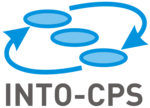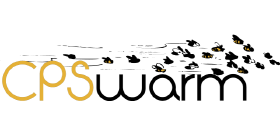Collaborations with other projects
INTO-CPS:

INTO-CPS project created an integrated “tool chain” for comprehensive Model-Based Design (MBD) of Cyber-Physical Systems (CPSs). The tool chain supports the multidisciplinary, collaborative modelling of CPSs from requirements, through design, down to realisation in hardware and software. This enables traceability at all stages of the development. The IP from this project has been transferred to the INTO-CPS Association after the completion of the project.
Different approaches on traceability mechanisms were discussed to share knowledge.
REVAMP:

The ITEA 3 project REVaMP² aims to conceive, develop and evaluate the first comprehensive automation tool-chain and associated executable process to support round-trip engineering of SIS Product Lines and thereby helping to profitably engineer mass customised products and services in virtually any economic sector.
Joint collaboration in the development of one of the MegaM@Rt2 use cases provided by Volvo.
CPSWarm:

CPSwarm proposes a new science of system integration and tools to support engineering of CPS swarms. CPSwarm tools will ease development and integration of complex herds of heterogeneous CPS that collaborate based on local policies and that exhibit a collective behavior capable of solving complex, industrial-driven, real-world problems.
Joint development over Modelio, one of the tools in the MegaM@Rt2 catalog, to make it compatible with CPS swarms.
MODELS:

The project developed a unified environment for the design of system applications on parallel platforms based on CPU, multicore, manycore, FPGA and heterogeneous SoCs. The design tools composing this environment provide a unified SW/HW specification interface and systematic procedures for composing models at different abstraction levels allowing for the automatic validation, drastically reducing the verification and debugging efforts.
Joint development over Modelio, one of the tools in the MegaM@Rt2 catalog, to make it compatible with MODEL’s methods for data flow modelling of embedded system.
Platform4CPS:

Platform4CPS was a Coordination and Support Action in the area of the Smart Cyber-Physical Systems to develop roadmaps and support platforms in the area of CPS.
MegaM@Rt2 results shared with Platform4CPS in order to create a community of interest around them.
MEASURE:

The goal of the project is to increase the quality and efficiency as well as reduce the costs and time-to-market of software engineering in Europe. By implementing a comprehensive set of tools for automated and continuous measurement, this project provides a toolset for future projects to properly measure their impact. More importantly, it opens a new field for innovation. The real innovation will be in the advanced analytics of the measurement data enabled by the project.
MEASURE’s metrics and measurements metamodel has been made compatible with MegaM@Rt2 to benefit from the developed traceability and analysis methods.
Q-Rapids:

Q-Rapids defines an empirical-based data-driven quality–aware rapid software development framework.
MegaM@Rt2 results have been presented to Q-Rapids consortium in order to create a community of interest around them.
CROSSMINER:

The overarching aim of CROSSMINER is to deliver an integrated open-source platform that will support the development of complex software systems by (1) enabling monitoring, in-depth analysis and evidence-based selection of open source components, and (2) facilitating knowledge extraction from large open-source software repositories.
MegaM@Rt2 results have been presented to CROSSMINER consortium in order to create a community of interest around them.
MINEStrA:
MINEStrA aims at providing a system integration approach supporting early behavioural analysis and simulation based on executable models. Executable models will be automatically derived from the different views of the system design in order to (i) provide a common denominator for behavioural semantics of the different points of view of the system, and (ii) allow the simulation and analysis of the integrated system behaviour as a whole. This early validation and verification activity permits to identify infeasible configurations and anticipate possible pitfalls in the final system, thus allowing to lower development time and costs. Moreover, back-propagation of analysis results is made easier thanks to the level of abstraction at which the validation is performed.
Joint collaboration to develop NATLABS tool, used in the MegaM@Rt2 use case provided by Bombardier.
XIVT:

The project develops a platform for efficient and effective variant testing.
Joint collaboration to develop VARA tool, used in the MegaM@Rt2 use case provided by Bombardier.
AQUAS:
![]()
The AQUAS project investigates the challenges arising from the inter-dependence of safety, security and performance of systems and aims at efficient solutions for the entire product life-cycle within three essential capabilities of the ECSEL: Design Technologies (DT), Cyber-Physical Systems (CPS), and European Asset Protection (EAP). The project builds on knowledge of partners gained in current or former EU projects and will demonstrate the newly conceived approaches across use cases spanning: Space, Medicine, Transport and Industrial Control.
Joint effort on standardization to identify technical requirements for a next version of MARTE, finally presented to OMG.
AMASS:

AMASS creates and consolidates the de-facto European-wide open tool platform, ecosystem, and self-sustainable community for assurance and certification of Cyber-Physical Systems (CPS) in the largest industrial vertical markets including automotive, railway, aerospace, space, energy. The ultimate goal of AMASS is to lower certification costs for CPS in face of rapidly changing features and market needs. This is achieved by establishing a novel holistic and reuse-oriented approach for architecture-driven assurance (fully compatible with standards such as AUTOSAR and IMA), multi-concern assurance (for co-analysis and co-assurance of e.g. security and safety aspects), and for seamless interoperability between assurance and engineering activities along with third-party activities (e.g. external assessments and supplier assurance).
Joint collaboration to integrate one of the MegaM@Rt2 tools, CHESS, with OpenCerth platform and apply them into one of the MegaM@Rt2 use cases provided by Tekne.
SafeCOP:

SafeCOP targets safety-related Cooperating Cyber-Physical Systems (CO-CPS) characterised by use of wireless communication, multiple stakeholders, dynamic system definitions (openness), and unpredictable operating environments. It provides an approach to the safety assurance of CO-CPS, enabling their certification and development. The project defines a runtime manager architecture for runtime detection of abnormal behaviour, triggering if needed a safe degraded mode. SafeCOP also developed methods and tools used to produce safety assurance evidence needed to certify co-operative functions and extended current wireless technologies to ensure safe and secure cooperation. SafeCOP also contributed to new standards and regulations, by providing certification authorities and standardization committees with the scientifically validated solutions needed to craft effective standards extended to also address cooperation and system-of-systems issues. SafeCOP brings clear benefits in terms of cross-domain certification practice and implementations of cooperating systems in all addressed areas: healthcare, maritime, vehicle-to-vehicle and vehicle-to-infrastructure.
Reuse of SafeCOP results to extend CHESS monitoring trace analysis based on the additional MegaM@Rt2 traceability research and applying the results to Tekne Use Case
CERBERO:

The Cross-layer modEl-based fRamework for multi-oBjective dEsign of Reconfigurable systems in unceRtain hybRid envirOnments (CERBERO) project aims at developing a design environment for CPS based of two pillars: a cross-layer model based approach to describe, optimize, and analyze the system and all its different views concurrently; an advanced adaptivity support based on a multi-layer autonomous engine. To overcome the limit of current tools, CERBERO provides: libraries of generic Key Performance Indicators for reconfigurable CPSs in hybrid/uncertain environments; novel formal and simulation-based methods; a continuous design environment guaranteeing early-stage analysis and optimization of functional and non-functional requirements, including energy, reliability and security.
CERBERO participated in the Open Hackathon organized by MegaM@Rt2 in the last edition of HiPEAC.
TYPHON:

TYPHON plans to develop a new modeling language (TyphonML) to support the design of hybrid polystores. Using TyphonML, engineers will be able to model the data that needs to be persisted in a homogeneous manner, abstracting over the specificities of the underlying technologies. The language will support modelling both open and closed datasets, i.e. datasets, which conform to an open or strict schema respectively.
Cross-fertilization to solve the complexity of defining metamodels that need to cover different aspects of the same complex system and put them in synergy.
COMPACT:

COMPACT is a EU-funded project, that aims to strengthen the cyber-resilience of local public administrations (LPAs). The tools, COMPACT will offer to achieve this encompass risk assessment tools, education services, monitoring services and knowledge sharing services.
Participation in a workshop organized by COMPACT at DATE conference to present the MegaM@Rt2 approach.
FitopTiVis:
![]()
FitOptiVis works on balancing power demand versus performance of the increasingly complex distributed configurations in Cyber-Physical Systems, reflected in the growing number of sensors, actuators and other smart devices, their growing autonomy, and the increased need for performance. This complexity increases even more when multiple heterogeneous sensor inputs are combined for analysis and through integration of both generic and specialised devices.
MegaM@Rt2 modeling techniques are being reused and extended to the modeling of dynamically reconfigurable video-processing systems.
ROTAN:
ROTAN aims at integrating a large and complex industrial microcontroller production line system managed by SECS-GEM protocol, to automate tests and improvement of performances.
MegaM@Rt2 results shared with ROTAN in order to create a community of interest around them.
ENABLE S3:

ENABLE-S3 is industry-driven and aspires to substitute today’s cost-intensive verification & validation efforts by more advanced and efficient methods to pave the way for the commercialization of highly automated cyber physical systems (ACPS). Pure simulation cannot cover physics in detail due to its limitations in modelling and computation. Real-world tests are too expensive, too time consuming and potentially dangerous. Thus, ENABLE-S3 aims at developing an innovative solution capable of combining both worlds in an optimized manner.
MegaM@Rt2 results shared with ENABLE S3 in order to create a community of interest around them.
Se4Sa:
The SE4SA (Software Engineering for Services and Applications) cluster aims to facilitate the discussion among the experts in the area to exchange experiences and competences and to identify research directions and challenges as well as common plans to address them.
MegaM@Rt2 is member of this cluster, and it has contributed to ICT 2020-2027 Research and Innovation Programme, identifying current and future challenges.
HIPEAC:

HiPEAC provides a platform for cross-disciplinary research collaboration, promotes the transformation of research results into products and services, and is an incubator for the next generation of world-class computer scientists.
MegaM@Rt2 is an active member in all its edition, organizing workshops and even co-located an open hackathon there.
Reboot IoT:

Reboot IoT Factory is a new model to revolutionize manufacturing productivity through co-creation and utilization of best-in-class IoT solutions in Finland. Forerunner factories, top-class research and prolific technology SMEs incubate solutions based on factory needs, research knowledge and identified business opportunities. Reboot IoT Factory brings together service and solution providers, industrial leaders and top research organizations to improve the competitiveness of Finnish manufacturing industry through digitalization.
Knowledge share between the two projects to foster the reuse of MegaM@Rt2 results into IoT Reboot.
EDGE:

In the Edge Analytics for Smart Diagnostics in Digital Machinery Concept (EDGE) project edge analytics that utilise information from the designing phase of an equipment and physical context (Digital twin), feedback of expert personnel (human-in-the-loop) and capacity of cloud environment in training, initialisation and parameterization, are reached for, so that optimal up-to-date analytics can be guaranteed The developed solutions and methods will be verified and validated using demonstrators (ship engine, forest machine, shipyard crane) and data collected from these systems.
Knowledge share between the two projects to foster the reuse of MegaM@Rt2 results into EDGE.
